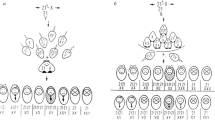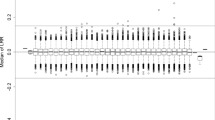Abstract
MEIOTIC studies on the human male during the past thirty years, notably those of Koller1 and Ford and Hamerton2, have shown that the X and Y chromosomes associate at meiotic prophase. Whether the chromosomes form a true chiasma or not has never been demonstrated convincingly. Because the position of the centromeres of the chromosomes cannot be identified with certainty in meiotic preparations, there has been much speculation as to whether it is the long or the short arms of the Y chromosome which associate with the X. Thus, Sasaki and Makino3 suggested that the X–Y chromosome association involved the short arms of the Y, and Hultén et al.4 suggested the long arms of the Y. The best cytological evidence has come from McIlree et al.5 on a male with a dicentric Y chromosome involving a presumptive deletion of the short arms. At diakinesis the dicentric Y chromosome did not associate with the X, and Jacobs therefore suggested that in normal circumstances the Y chromosome might have associated with the X by its short arms6. From phenotype–karyotype correlations, Ferguson-Smith7,8 deduced that part of the long arms of the Y chromosome was homologous with part of the short arms of the X, and that this region was involved in the X–Y association. From the appearance of the X–Y association at diakinesis in testicular biopsies from a population of normal males, we have tentatively concluded that the short arms of the Y chromosome are involved in associating with the X chromosome.
This is a preview of subscription content, access via your institution
Access options
Subscribe to this journal
Receive 51 print issues and online access
$199.00 per year
only $3.90 per issue
Buy this article
- Purchase on Springer Link
- Instant access to full article PDF
Prices may be subject to local taxes which are calculated during checkout
Similar content being viewed by others
References
Koller, P. C., Proc. Roy. Soc. Edinburgh, 57, 194 (1937).
Ford, C. E., and Hamerton, J. L., Nature, 178, 1020 (1956).
Sasaki, M., and Makino, S., Chromosoma, 16, 637 (1965).
Hultén, M., et al., Ann. Hum. Genet., 30, 119 (1966).
McIlree, M. E., et al., Lancet ii, 69 (1966).
Jacobs, P. A., Brit. Med. Bull., 25, 94 (1969).
Ferguson-Smith, M. A., J. Med. Genet., 2, 142 (1965).
Ferguson-Smith, M. A., Lancet, ii, 475 (1966).
Zech, L., Exp. Cell Res., 58, 463 (1969).
Vosa, C. G., Chromosoma (in the press).
Pearson, P. L., Bobrow, M., and Vosa, C. G., Nature, 226, 78 (1970).
Evans, E. P., et al., Cytogenetics, 3, 289 (1964).
Pearson, P. L., and Bobrow, M., J. Reprod. Fertil. (in the press).
Author information
Authors and Affiliations
Rights and permissions
About this article
Cite this article
PEARSON, P., BOBROW, M. Definitive Evidence for the Short Arm of the Y Chromosome associating with the X Chromosome during Meiosis in the Human Male. Nature 226, 959–961 (1970). https://doi.org/10.1038/226959a0
Received:
Issue Date:
DOI: https://doi.org/10.1038/226959a0
This article is cited by
-
A region of euchromatin coincides with an extensive tandem repeat on the mouse (Mus musculus) inactive X chromosome
Chromosome Research (2014)
-
The human pseudoautosomal regions: a review for genetic epidemiologists
European Journal of Human Genetics (2008)
-
Y chromosome polymorphism in various breeds of cattle (Bos taurus) in Switzerland
Journal of Applied Genetics (2007)
-
The pseudoautosomal regions of the human sex chromosomes
Human Genetics (1993)
-
The genetics of human reproduction
Experientia (1986)
Comments
By submitting a comment you agree to abide by our Terms and Community Guidelines. If you find something abusive or that does not comply with our terms or guidelines please flag it as inappropriate.



